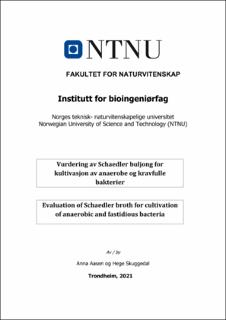| dc.contributor.advisor | Snøsen, Hege | |
| dc.contributor.advisor | Kroknes, Marthe Lind | |
| dc.contributor.advisor | Kristiansen, Kine Husteli | |
| dc.contributor.author | Aasen, Anna | |
| dc.contributor.author | Skuggedal, Hege | |
| dc.date.accessioned | 2021-09-25T16:59:11Z | |
| dc.date.available | 2021-09-25T16:59:11Z | |
| dc.date.issued | 2021 | |
| dc.identifier | no.ntnu:inspera:82853603:36979319 | |
| dc.identifier.uri | https://hdl.handle.net/11250/2783537 | |
| dc.description.abstract | Avdeling for Medisinsk Mikrobiologi på St. Olavs hospital bruker i dag Thioglycolat buljong som generelt anbefalt buljong for kultivasjon av anaerobe bakterier. I 2019 utførte avdelingen en preliminær studie, som viste at oppvekst av anaerobe og kravfulle bakterier i de fleste tilfeller forekom tidligere og mer rikelig ved kultivasjon i Schaedler buljong tilsatt askorbinsyre, enn i Thioglycolat buljong. Formålet med denne oppgaven er å utføre en videre evaluering om bruk av Schaedler buljong med og uten tilsats av askorbinsyre er fordelaktig i forhold til Thioglycolat buljong for dyrkning av anaerobe og kravfulle bakterier.
I prosjektet ble Schaedler buljongene fra produsentene Oxoid og Liofilchem, med og uten tilsats av 1 mg/ml askorbinsyre sammenlignet med dagens anaerob-buljong, Thioglycolat buljong. Det ble benyttet 21 fakultative og obligat anaerobe-, og syv hurtigvoksende og lite krevende bakteriestammer for å avgjøre kultivasjonsevnen til de totalt fem buljongtypene.
For hver bakteriestamme ble det laget en suspensjon med høy (10^8 CFU/ml) konsentrasjon og fra denne en suspensjon med lav (10^3 CFU/ml) konsentrasjon. Suspensjonene ble deretter inokulert i de fem ulike buljongene, totalt ti buljonger for hver bakteriestamme. Buljongene ble inkubert, og veksten vurdert og gradert daglig. Når veksten var rikelig nok ble det utført en subkultivasjon fra buljongene på agar for å sikre at bakteriene var levedyktige. Til slutt ble buljongene sin kultivasjonsevne rangert fra I-V for hver av de 21 bakteriestammene, ved de to ulike konsentrasjonene.
Resultatene viser at de fleste bakteriestammene vokste tidligere og mer rikelig i Schaedler buljongene tilsatt askorbinsyre, sammenlignet med Schaedler buljongene uten askorbinsyre. Buljongene med tilsats av askorbinsyre ga stort sett like gode eller bedre kultivasjonsresultater enn Thioglycolat buljong. De vurderes derfor som gode erstatningsalternativer for dyrkning av anaerobe og kravfulle bakterier. Ut ifra undersøkelsene i dette prosjektet er Schaedler buljong tilsatt askorbinsyre fra produsenten Liofilchem det beste alternativet.
En eventuell overgang til å bruke Schaedler buljong med askorbinsyre kan effektivisere det diagnostiske arbeidet ved Avdeling for Medisinsk Mikrobiologi. Det kan gjøre det mulig å kultivere anaerobe og kravfulle bakterier lettere, og dermed identifisere de tidligere enn i dag, noe som er til stor fordel for pasienten. | |
| dc.description.abstract | The Department of Medical Microbiology at St.Olavs hospital uses Thioglycolat broth as a generally recommended broth for cultivation of anaerobic bacteria. In 2019 the department executed a preliminary study. The study showed that growth of anaerobic and fastidious bacteria occurred in most cases earlier and more abundantly, during cultivation in Schaedler broth with asorbic acid, than in Thioglycolat broth. The aim of this project is to evaluate if Schaedler broth with and without asorbic acid is more advantageous for cultivation of anaerobic and fastidious bacteria, than Thioglycolat broth.
In this project Schaedler broth from the producers Oxoid and Liofilchem, with and without additive of 1 mg/ml asorbic acid, was compared with the anaerobic broth used as todays standard, Thioglycolat broth. 21 facultative and strict anaerobic bacterial strains, and seven fast growing and non demanding bacterial strains were used to determine the cultivating ability of the five broths.
For each bacterial strain, a high (10^8 CFU/ml) concentration suspension was made, and from this a low (10^3 CFU/ml) concentration suspension was created. The suspensions were then inoculated into the five different broths, a total of ten broths for each bacterial strain. The broths were incubated and the growth was evaluated and graded daily. When the growth was adequately abundant enough, a subcultivation was performed from the broths to agar, to ensure that the bacteria were viable. Finally, each of the broths cultivating ability was ranked from I-V for each of the 21 bacterial strains, at the two different concentrations.
The results show that most bacterial strains grew earlier and more abundantly in the Schaedler broths with the addition of ascorbic acid, compared to the Schaedler broths without ascorbic acid. The broths with the addition of ascorbic acid gave generally equal or better cultivation results than Thioglycolate broth, and are therefore considered as good replacement alternatives. Based on the research in this project, Schaedler broth with added ascorbic acid from the manufacturer Liofilchem is the best alternative.
A possible transition to using Schaedler broth with ascorbic acid at the Department of Medical Microbiology can simplify the diagnostic work. It can make it possible to cultivate anaerobic and fastidious bacteria more easily, and thus identify them earlier than today, which is of great benefit to the patient. | |
| dc.language | nob | |
| dc.publisher | NTNU | |
| dc.title | Vurdering av Schaedler buljong for kultivasjon av anaerobe og kravfulle bakterier | |
| dc.type | Bachelor thesis | |
